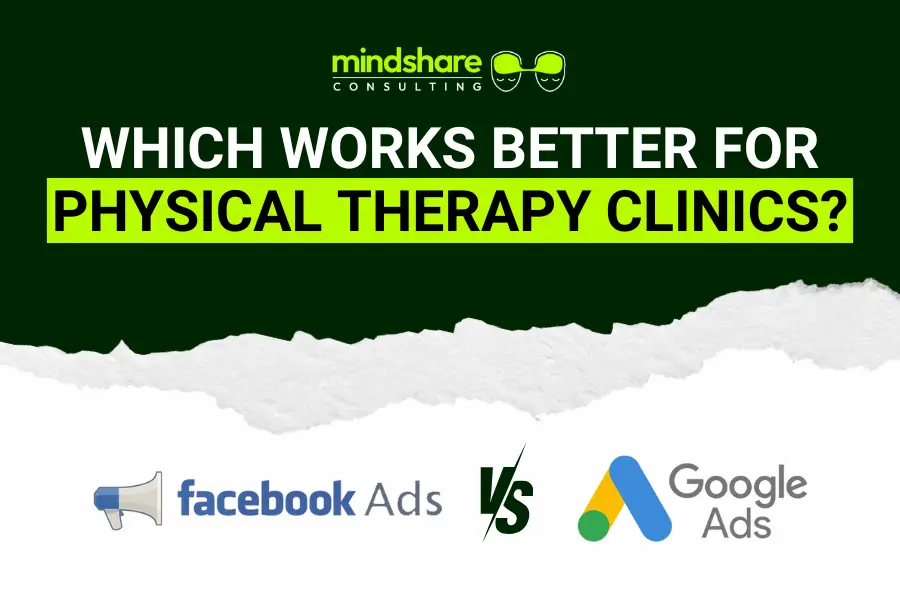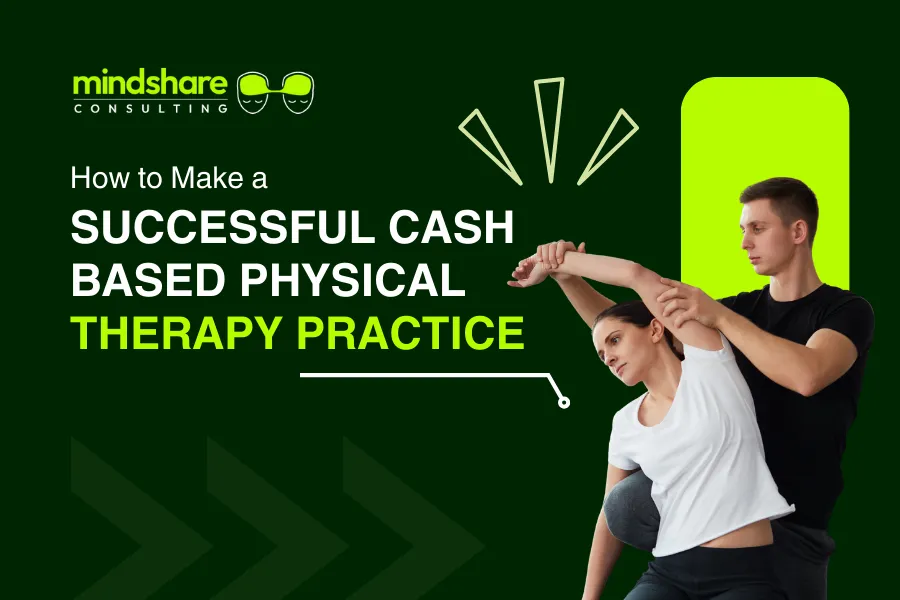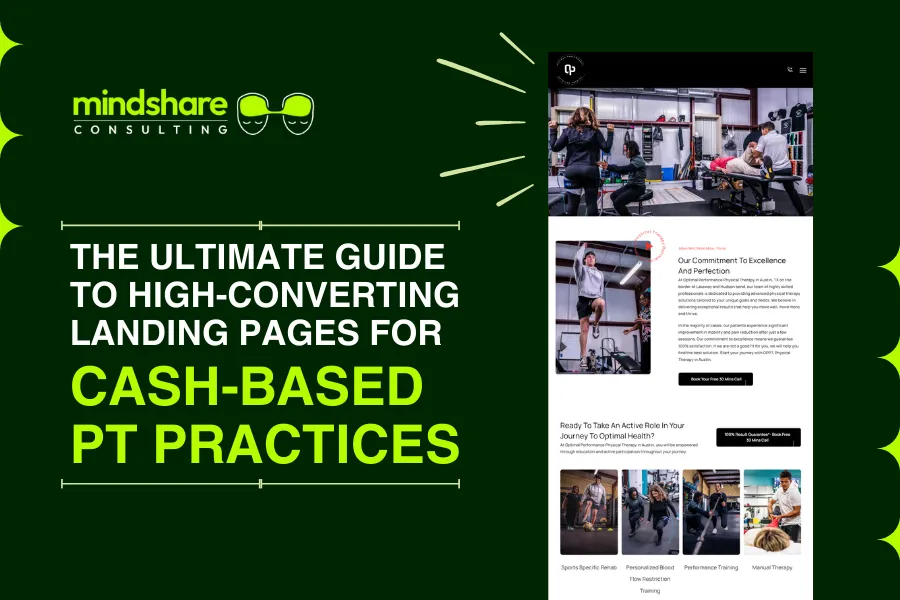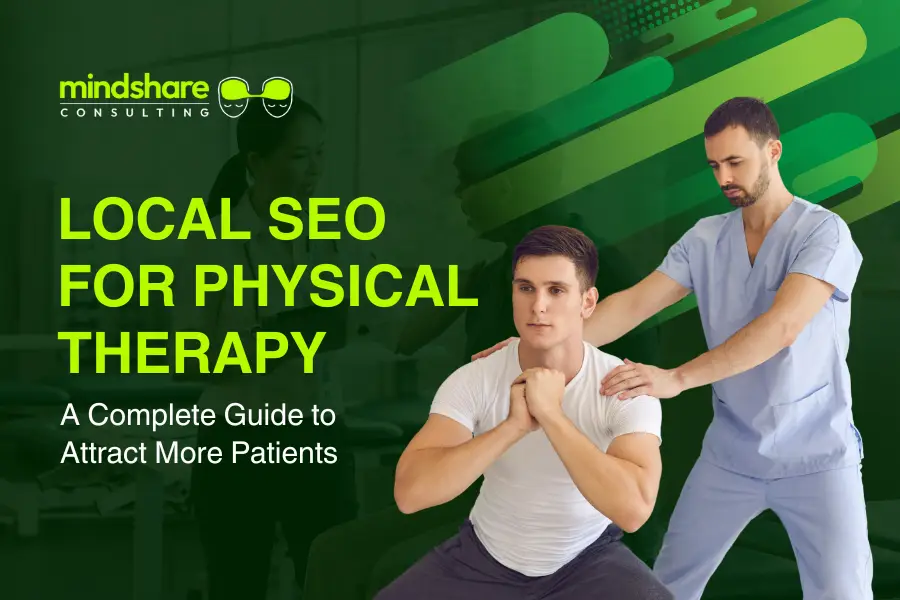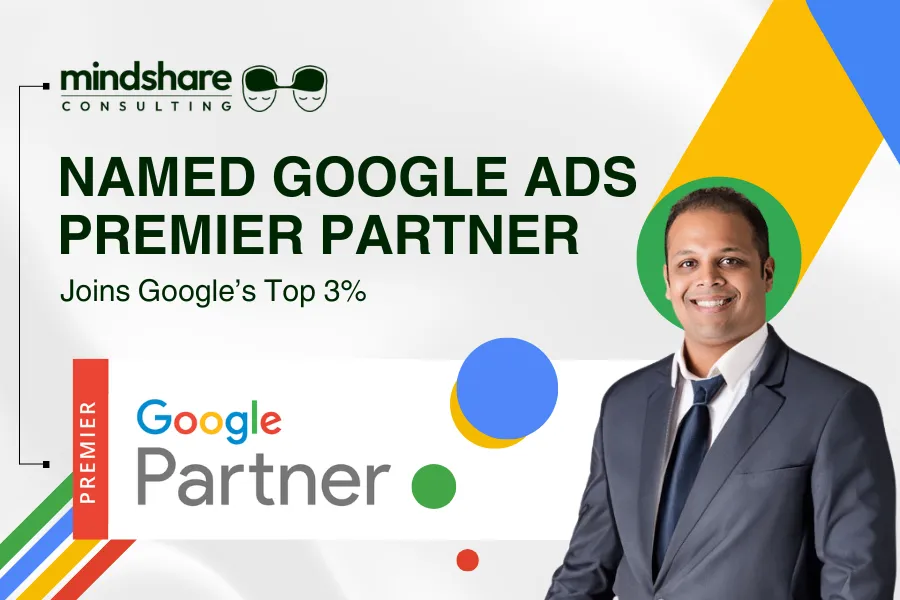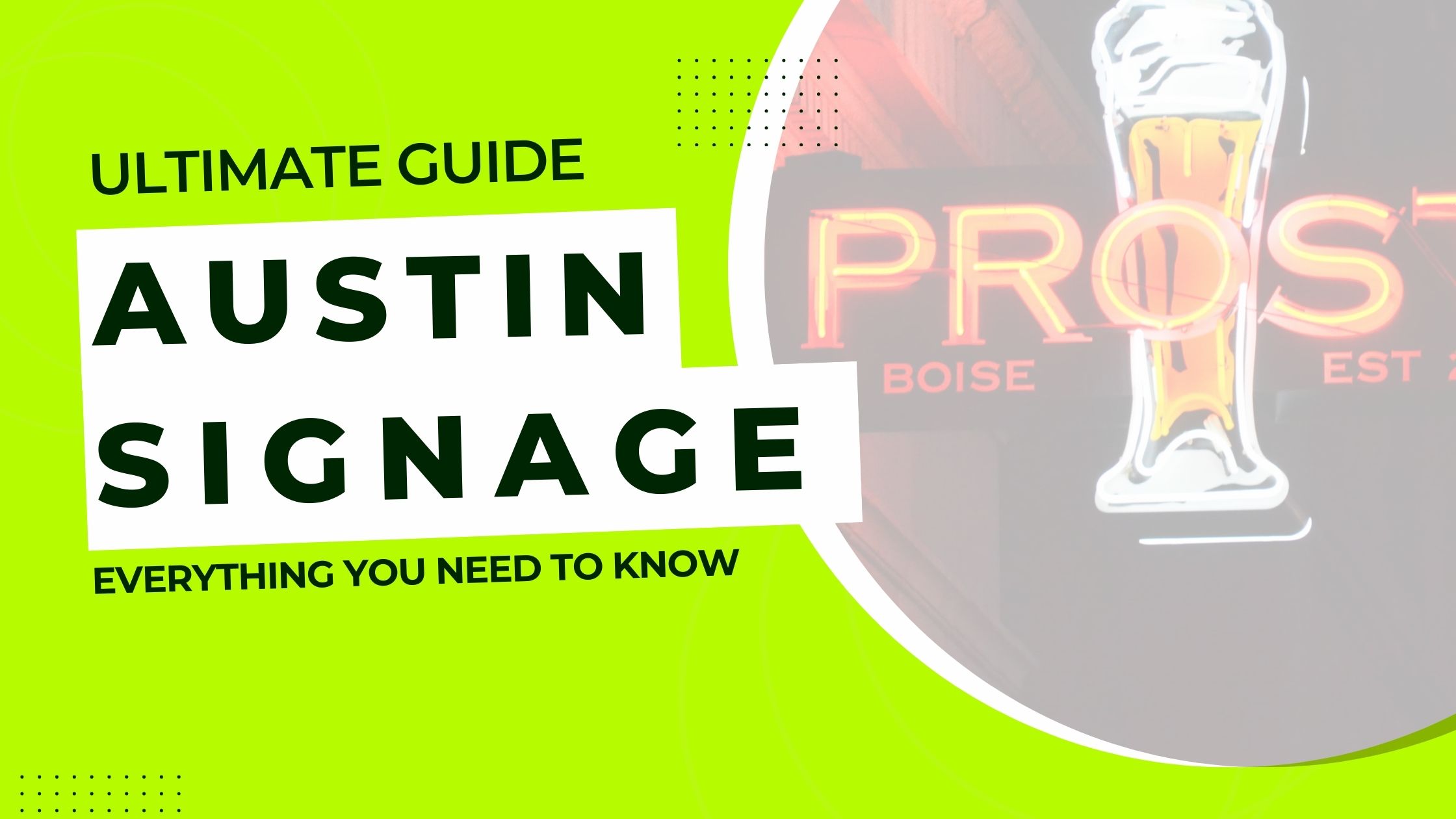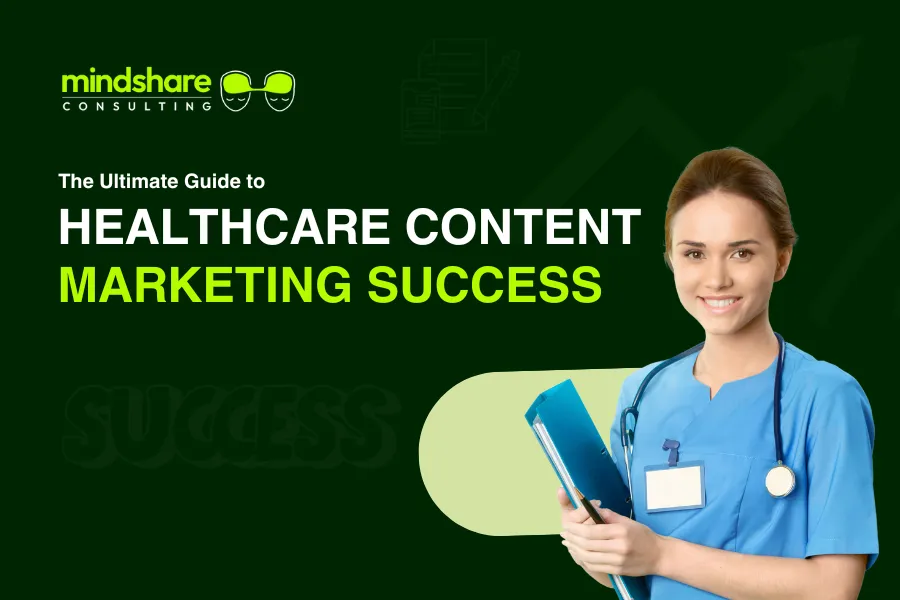Marketing is essential for physical therapy clinics to attract new patients and grow their practice. However, choosing the right advertising platform can be challenging. Two of the most effective digital marketing channels are Google Ads and Facebook Ads, each offering distinct advantages. But which one works best for physical therapy clinics?
Google Ads connects businesses with people actively searching for physical therapy services. On the other hand, Facebook Ads enable clinics to reach potential patients through targeted social media campaigns.
In this detailed guide, we’ll compare Google Ads and Facebook Ads for physical therapy clinics, analyzing their strengths, weaknesses, and best use cases. We’ll also discuss how Mindshare Consulting Inc can help optimize your digital marketing strategy for physical therapy to maximize your return on investment (ROI). By the end, you’ll have a clear understanding of which advertising method is best suited for your clinic’s needs.
Understanding Google Ads and Facebook Ads
Before diving into a detailed comparison, let’s take a look at how each platform works and what makes them unique.
-
What is Google Ads?
Google Ads is a pay-per-click (PPC) advertising platform that displays ads on Google Search, YouTube, and other partnered websites. With Google Ads, businesses can bid on specific keywords, ensuring that their ads appear when users search for relevant terms like “best physical therapy clinic near me” or “sports injury rehabilitation.”
- Search Ads: These appear at the top of Google search results when someone types in a query.
- Display Ads: Image-based ads that appear on various websites within Google’s Display Network.
- Video Ads: Short promotional videos that run before or during YouTube content.
- Local Services Ads: Designed specifically for service-based businesses, helping local clinics appear in Google’s “local pack.
Google Ads work best for physical therapy clinics looking to capture high-intent leads—people who are actively searching for treatment.
-
Benefits of Google Ads for Physical Therapy Clinics
- High Intent Traffic – Users searching for “best physical therapy clinic near me” are actively looking for services, making them high-conversion prospects.
- Immediate Visibility – Ads appear at the top of search results, ahead of organic listings, ensuring maximum visibility.
- Targeted Advertising – You can target ads based on keywords, location, device, and even audience demographics.
- Measurable ROI – Google Ads provides detailed performance metrics, allowing you to track clicks, conversions, and cost-per-acquisition.
- Call-Only Ads – Enables potential patients to call your clinic directly from the ad.
- Performance Tracking – Provides detailed insights into ad performance and conversions.
-
Challenges of Google Ads
- Higher Cost-Per-Click (CPC) – Since Google Ads operates on a bidding system, competitive keywords can be expensive.
- Requires Optimization – Campaigns need continuous monitoring and optimization to remain cost-effective.
- Limited Social Engagement – Google Ads doesn’t provide the same level of social interaction as Facebook Ads.
Understanding Facebook Ads for Physical Therapy Clinics
What is Facebook Ads?
Facebook Ads work differently from Google Ads. Instead of targeting users based on search queries, Facebook allows businesses to reach people based on their demographics, interests, behaviors, and online activity. This means clinics can showcase their services to potential patients who may not be actively searching but fit the profile of someone in need of physical therapy.
- Image & Video Ads: These appear on users’ newsfeeds, in stories, or on Instagram.
- Carousel Ads: Multiple images or videos in one ad, ideal for showcasing different treatments.
- Lead Ads: Forms built directly into Facebook for easy appointment scheduling.
- Retargeting Ads: Target users who previously visited your website but didn’t book an appointment.
Facebook Ads are highly effective for building brand awareness and patient engagement over time.
Benefits of Facebook Ads for Physical Therapy Clinics
- Advanced Audience Targeting – Clinics can target users based on location, age, interests, health behaviors, and more.
- Cost-Effective – Facebook Ads often have a lower cost-per-impression (CPM) compared to Google Ads, making them affordable for small businesses.
- Engaging Ad Formats – Video ads, carousel ads, and interactive formats help in increasing brand awareness.
- Retargeting Capabilities – Clinics can re-engage past visitors who didn’t book an appointment the first time.
Challenges of Facebook Ads
- Lower Intent Traffic – Unlike Google, users aren’t actively searching for physical therapy services.
- Ad Fatigue – Users may see the same ad repeatedly, reducing its effectiveness.
- Algorithm Dependence – Facebook’s ad delivery depends on its algorithm, requiring frequent adjustments.
- Algorithm Changes – Facebook frequently updates its advertising policies, which may affect ad performance.
- Creative Dependency – Requires engaging visuals and ad copy to capture attention.
Targeting Capabilities
Targeting the right audience is crucial for successful advertising. Let’s compare how both platforms handle targeting.
-
Google Ads Targeting
Google Ads allows advertisers to reach people based on:
- Keywords: Targeting users actively searching for physical therapy services.
- Location: Ads can be shown within a specific radius of your clinic.
- Device Type: Optimizing for mobile, desktop, or tablet users.
- Ad Scheduling: Running ads during peak appointment booking hours.
Google’s search-based targeting ensures that ads are only shown to people with high purchase intent, making it ideal for clinics seeking immediate patient conversions.
-
Facebook Ads Targeting
Facebook Ads rely on behavioral and demographic targeting, including:
- Age, Gender, and Location: Useful for targeting local communities.
- Interests & Hobbies: Showing ads to users interested in fitness, health, and wellness.
- Custom Audiences: Retargeting users who have visited your website.
- Lookalike Audiences: Expanding reach by finding similar potential patients.
Facebook Ads work best for creating long-term patient relationships and brand visibility.
Cost and Budget Considerations
Advertising budgets are often a concern for clinics. Let’s examine how the costs compare between Google and Facebook Ads.
- Google Ads Average CPC: $2–$5 for healthcare-related keywords.
- Facebook Ads Average CPC: $1–$3, depending on audience targeting.
- Google Ads Requires Higher Bids: Since keywords like “physical therapy near me” have high competition.
- Facebook Ads Lower Costs: But require repeated exposure to convert users into patients.
For clinics on a tight budget, Facebook Ads offer a lower entry cost, while Google Ads deliver faster patient inquiries at a higher price.
User Intent and Ad Performance
- Google Ads: High-intent users actively searching for physical therapy services.
- Facebook Ads: Passive users discovering physical therapy services through targeted ads.
Google Ads often drive faster results, while Facebook Ads require a longer nurturing process but improve brand recognition.
Google Ads vs. Facebook Ads: A Side-by-Side Comparison
| Feature | Google Ads | Facebook Ads |
| User Intent | High (users actively searching) | Low (users passively scrolling) |
| Ad Cost | Higher CPC | Lower CPM |
| Audience Targeting | Based on search queries & demographics | Based on interests, behaviors, and demographics |
| Best for | Immediate lead generation | Brand awareness and engagement |
| Ad Formats | Search ads, display ads | Image ads, video ads, carousel ads |
Which Platform is Best for Physical Therapy Clinics?
Use Google Ads if:
- You want to attract patients who are actively searching for physical therapy services.
- Your goal is immediate lead generation with a high conversion rate.
- You have a higher budget to compete in a competitive market.
Use Facebook Ads if:
- You want to increase brand awareness and engage with potential patients.
- You are targeting a specific demographic that may need physical therapy services in the future.
- You have a limited budget and want a cost-effective way to reach more people.
Best Strategy: Combine Both
A powerful marketing strategy for physical therapy clinics involves using both Google Ads and Facebook Ads together:
- Use Google Ads to capture high-intent leads searching for immediate services.
- Use Facebook Ads to nurture relationships and build brand loyalty over time.
Which One Should You Choose?
For physical therapy clinics, the best approach is often a combination of both platforms. Use Google Ads for high-intent searches and Facebook Ads for patient education and engagement. This ensures you attract immediate leads while also building long-term patient relationships.
Deciding between Google Ads and Facebook Ads for your physical therapy clinic depends on your goals, budget, and target audience. Here’s a breakdown to help you decide:
- Choose Google Ads if: You want to capture high-intent users actively searching for physical therapy services. Google Ads can provide immediate conversions from users looking for solutions.
- Choose Facebook Ads if: You want to build brand awareness, engage potential clients over time, and target specific demographics through interest-based advertising.
- Use Both if: You want to maximize your reach and leverage both search intent and social engagement to attract new clients.
At Mindshare Consulting, we specialize in crafting high-performing ad campaigns tailored to your needs. Whether you need precise keyword targeting with Google Ads or a robust social media marketing with Facebook Ads, our team can help drive results. Contact us today to get started!
Mindshare Consulting: Your Partner for Digital Advertising Success
Mindshare Consulting specializes in helping physical therapy clinics maximize their online advertising ROI. Our expert digital marketing team creates high-performance campaigns on both Google Ads and Facebook Ads. Our services include:
- Google Ads Management – Keyword research, ad copywriting, bid optimization, and performance tracking.
- Facebook Ads Management – Audience targeting, creative ad development, and conversion tracking.
- SEO & Content Marketing – Optimized website content to improve organic search rankings.
- Social Media Strategy – Engagement-driven campaigns to connect with potential patients.
- Analytics & Reporting – Data-driven insights to improve advertising efficiency.
For a tailored strategy to grow your clinic’s online presence, visit Mindshare Consulting today.
Conclusion
Both Google Ads and Facebook Ads offer unique benefits for physical therapy clinics. Google Ads is ideal for attracting high-intent leads, while Facebook Ads excel at brand awareness and engagement. For the best results, consider using both platforms strategically.
If you need expert guidance in setting up and managing high-performing ad campaigns, Mindshare Consulting is here to help.
Contact us today for a free consultation and let’s grow your clinic’s online presence together!
FAQs
Which is more cost-effective, Google Ads or Facebook Ads?
Google Ads tends to have a higher cost per click (CPC) but brings in higher-intent users. Facebook Ads are generally more affordable but require more nurturing.
How much should I spend on Google Ads for my clinic?
Budgets vary, but most physical therapy clinics spend between $500–$5000 per month depending on competition and location.
How do I target the right audience on Facebook Ads?
Use demographics, interests, and behaviors to target potential patients. Retargeting website visitors is also effective.
Can I run both Google Ads and Facebook Ads at the same time?
Yes! Combining both platforms helps maximize visibility and attract patients at different stages of their journey.
How do I track the success of my ads?
Use tools like Google Analytics, Facebook Pixel, and UTM parameters to track leads and conversions.
What type of ad copy works best for physical therapy clinics?
Focus on patient benefits, testimonials, and clear calls to action like “Book an Appointment Today.”
How long does it take to see results from paid advertising?
Google Ads can generate leads immediately, while Facebook Ads often require several weeks of testing and optimization.

